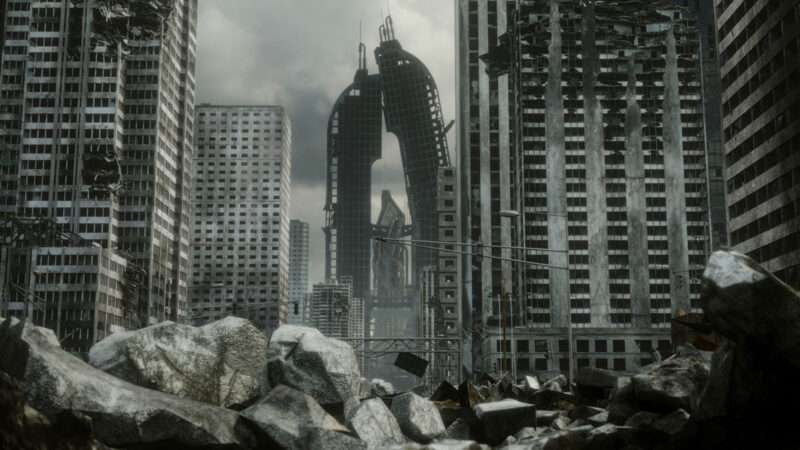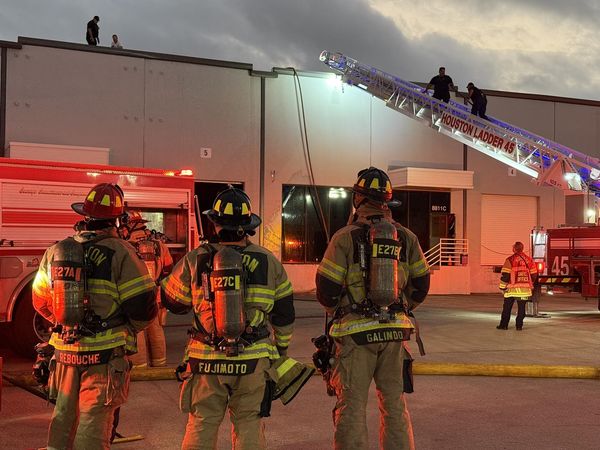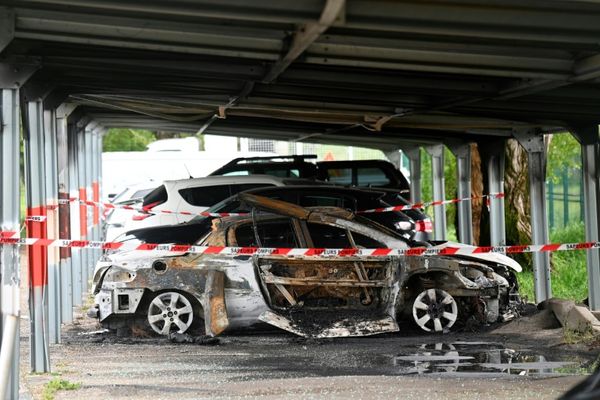
Nuclear War: A Scenario, by Annie Jacobsen, Dutton, 400 pages, $30
The end of the world takes less than two hours in Annie Jacobsen's Nuclear War: A Scenario. It begins one spring day when a nuclear intercontinental ballistic missile (ICBM) erupts from a mobile launcher in North Korea. Before it hits the Pentagon, a North Korean submarine in the Pacific fires a second nuclear salvo at California. Neither missile is intercepted. Within 40 minutes of the first launch, millions of Americans are dead on both coasts.
The U.S. retaliates by firing a barrage of missiles from underground installations in the Mountain West and from submarines in the Pacific. Russia, aware that the United States has been attacked but unable to communicate with the U.S. president, mistakes the launch of the American ICBMs for an attack on Moscow and fires its nuclear weapons at the U.S. and its NATO allies, which then retaliate against Russia.
North Korea finishes the play by detonating a nuclear bomb attached to a satellite over North America, generating a series of electromagnetic pulses that destroy the United States' three main electrical grids and plunge the country back into the early 19th century.
The entire scenario—a word Jacobsen uses frequently, first clinically and then almost as a merciful reminder that the events in her book are entirely speculative—lasts roughly as long as an episode of Jack Ryan, for which Jacobsen has been both a consultant and a writer.
In this span, hundreds of millions of people die instantly. Hundreds of millions more begin to die from radiation poisoning and third-degree burns, then starvation, dehydration, and exposure. The war ends up killing 2 billion in total. Numerous monuments, buildings, and works of art across five continents are destroyed in finger-snap intervals. The Vatican is rubble; the pope is ash. The Louvre, St. Basil's Cathedral, the Empire State Building, Hollywood, and Buckingham Palace explode and shatter like movie props.
In case her readers are not sufficiently disturbed by the rapid immiseration of the human race, Jacobsen informs us on page 212 that animals will also suffer in a nuclear war. At the National Zoo in Washington, D.C., four miles north of ground zero, "Asian elephants, western lowland gorillas, and Sumatran tigers writhe and bellow in their cages and their pens. Most have charred skin hanging off their bodies, their hair on fire."
After this very short, very awful conflict, nothing works and no place is safe. Most of the water is radiated, and dead bodies are everywhere. The sun disappears behind a cloud of particulate matter that hangs between the Earth and the rest of the solar system, plunging the planet into a short but devastating ice age. When the sun returns, it does so absent most of the ozone layer, making solar rays deadly to human beings, very few of whom are left. "Survivors," she writes, "must move underground. Into the damp and the dark. Into spaces infested with spiders and insects, like sucking louse." To paraphrase Nikita Khrushchev, parents of day care–age children will envy the dead.
What evidence is there that the launch of two North Korean nukes would catalyze the death of billions and the end of civilization as we know it?
"The scenario I chose was pieced together from interviews I did with 46 on-the-record sources and dozens of sources on background, and I ran by them various scenarios to come up with the most plausible scenario that unfolds once it begins," Jacobsen told Politico's Kathy Gilsinan. "And this is what I came up with. And so far, I haven't had anyone who actually runs these scenarios for NORAD take issue with the choices that I've made and the way in which the decision trees unfold, which makes it all the more frightening."
That kind of sensationalism is Jacobsen's calling card, as is her method of "piecing together" interviews with various military types to form a larger picture. The combination has led to some wild swings and proportionately big misses. In 2011's Area 51: An Uncensored History of America's Top Secret Military Base, Jacobsen chronicled the development of American spy planes in the Nevada desert and the U.S. government's efforts to suppress civilian interest in its homegrown UFOs. The Pulitzer-winning historian Richard Rhodes took to The Washington Post to declare it an "adequate if error-ridden job" built on the "classic investigative method of interviewing dozens and dozens of worker bees from engineers to security guards and piecing their stories together." He had no patience for Jacobsen's willingness to endorse the theory "that Auschwitz butcher Dr. Josef Mengele, the German aircraft-designing brothers Walter and Reimar Horten and Soviet dictator Josef Stalin conspired back in the late 1940s to scare America silly with a Nazi-Soviet flying saucer crowded with wobbly 13-year-olds with large, surgically altered heads." He is referring, of course, to the supposedly alien spacecraft that crashed in 1947 near Roswell, New Mexico.
Despite such criticism, Area 51 sold well, and Jacobsen stood by her reporting on the Roswell theory just as she now stands by her speculative tick-tock of a future nuclear war. If anything, her thesis this time is even more unfalsifiable. Maybe Kim Jong Un really is the kind of lunatic who would destroy his own people to smite the U.S. for publishing a NASA satellite photo of the Korean Peninsula at night, in which North Korea is shrouded in darkness while South Korea is ablaze with electricity. (This is the closest Jacobsen comes to suggesting a cause for the dictator's "Bolt out of the Blue" nuclear attack.) Maybe an American president, pressured by his military advisers, really would launch 82 nuclear warheads in response, genociding the North Korean people, most of whom are essentially slaves. Maybe Russia's leaders, convinced that the U.S. is itching to do to Vladimir Putin what it did to Saddam Hussein, really would lean into its paranoia and nuke the U.S. before confirming whether it was actually under attack.
Before too many chapters, a reader may find themselves echoing the lament of Ebenezer Scrooge during his visit to the future with the Ghost of Christmas Yet to Come: "No more! No more! I don't wish to see it. Show me no more!"
Unlike Scrooge, who was able to stave off damnation with a fat goose and better PTO, the average reader is no more capable of affecting nuclear proliferation than stopping tectonic plate movement. But there are less consternating ways to engage with Jacobsen's book, which is already being adapted for the big screen. While dread-inducing as a risk assessment, it is a fantastic entry in the genre of disaster porn. New Yorker writer Kathryn Schulz set the standard for this category with her breathtaking 2015 piece, "The Really Big One," about an earthquake that could destroy the western half of the United States. More staid entries include a briefly viral 2014 geology paper modeling the Midwest-destroying effects of a Yellowstone supereruption. And then, of course, there is the pi-long shelf of climate change projections. Between Hollywood and the eggheads, science-based eschatology is very hot right now.
I do not mean to jest about the specter of nuclear holocaust. As Jacobsen makes clear, modern nuclear weapons, of which there are several thousand between just the U.S. and Russia, are hundreds of times more devastating than the two bombs America dropped on Japan to end World War II in the Pacific. Detonating just one thermo-nuclear device would not merely destroy everyone and everything in a multimile radius: The ensuing fallout would salt the Earth for miles and miles beyond ground zero.
So where can one find solace? Jacobsen offers none, but I thought of Kim Jong Un as I finished her book. The young dictator is reportedly a lover of French wines and Swiss cheese; he is said to enjoy the company of attractive women; his bulletproof personal train allegedly has pink leather seats; he recently built eight new luxury mansions. Is he eager to give all that up for a hole in the ground and an empire of disgruntled cave dwellers? Does he have enough Bordeaux to survive a nuclear winter? Are the military leaders in his entourage ready to give up their lavish lifestyles? What about Putin and his inner circle? How, I wonder, do they feel about lice?
The leader of every nuclear power is unique, but they all have it good. May each of them read Jacobsen's book and exclaim, "Show me no more!"
The post <i>Nuclear War: A Scenario</i> Is a Disaster Porn Thriller appeared first on Reason.com.







